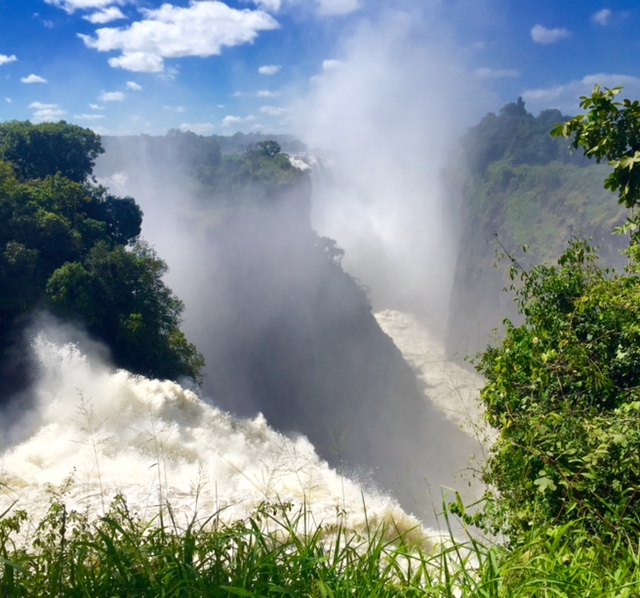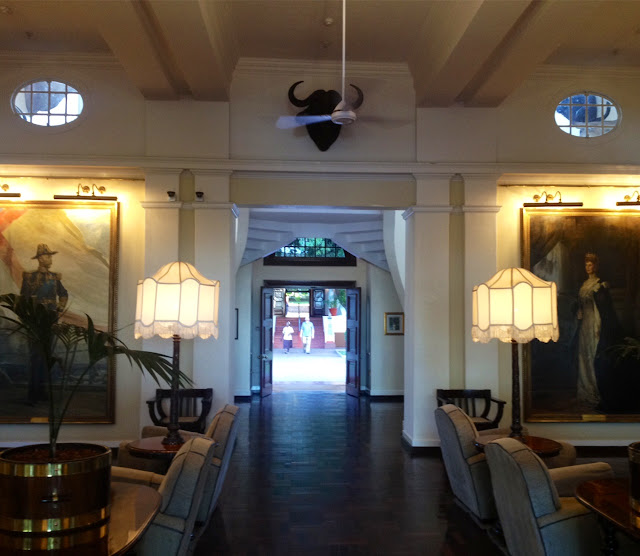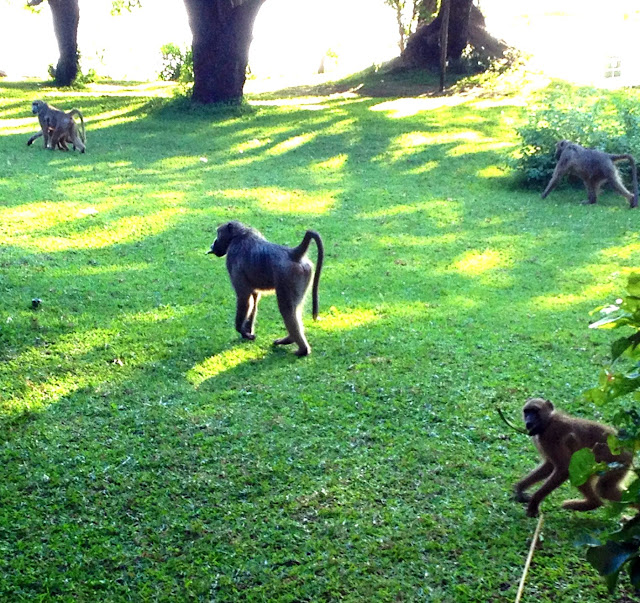Where do you start with a day like this?
One of the target destinations - in fact THE target destination - of this trip to southern Africa was Victoria Falls. Unfortunately, as the schedule went, we came here last. We went and saw a bunch of wonderful things in the last ten days (after leaving Senegal) but always in the back of our minds was this place.
But today was the day ... in more ways than one!
We set out early from here in Zimbabwe in the town of Victoria Falls. We had a full day planned, as we start for home tomorrow. It's our first time in Zimbabwe, and our hotel here is within walking distance of the Falls. You can see the mist fill the sky and you can hear the Falls.
We were not disappointed. Victoria Falls is one of the natural wonders of the world and is a gigantic cataract set of waterfalls, in fact it is almost like a giant curtain of water. It stretches over a mile wide. You can hear it before you see it, and currently it's high season for the water flow, the highest of the year.
You are first met with a statue of David Livingstone, the Scottish explorer who discovered the Falls in 1855, and for whom the nearby town in Zambia is named. History buffs might recall the famous saying when Henry Morton Stanley finally encountered the explorer and calmly stated: "Doctor Livingstone I presume?"
At one end of the Falls you find the voluminous Cataract Falls, that cascade over the edge of a 300 foot drop. The Falls are so intense that they send up a continuous plume of water vapor that sometimes obscures the view.
In fact, at certain points in the hike along the edge, you get soaked. Everyone wears a poncho, even though it's 81 degrees F and bright sunshine.
The volume and size outweigh almost all other waterfalls in the world, with the exception of Iguazu Falls in Paraguay/Brazil (been there!) and Niagara Falls (been there too).
We enjoyed the hike for three hours and were amazed by the views. At one point, we came across at gazelle/impala critter right by the path. Normally they are quite shy in the wilderness, but paid us no mind.
At the end of the hike on the Zimbabwe side, we came to the Victoria Falls Bridge, a spectacular structure built across a wide and deep gorge, with it's own rainbow underneath. More on this gorge later - stay tuned.
We eventually walked across the bridge, which is a famous spot for bungee jumping (we did something almost as exciting - read on). From the bridge you have a great view of the other end of the Falls, in the Zambia side.
It's one of those places where you just cannot get enough of it and could watch it all day. But we had other things to do and eventually left the bridge and the Falls and headed to our next destination, with a high degree of anticipation.
Zimbabwe, Zambia, and a Zip Line across the gorge ... !
So Fiona had her birthday last week, you might have seen the video of her wonderful serenade by the hotel staff. I gave her a gift that we had both thought about - a zip line excursion for her (along with me) across the Victoria Falls gorge.
This is a major canyon, we could see it from the bridge, it's probably close to a thousand feet deep! Yikes! This ain't no tree top zip line, it's major league! But we were committed to it, and walked the trail to the edge. All day long we had thought about this, and were surprisingly calm ... until we got there.
Now keep in mind that neither I nor Fiona are the dare-devil types. In fact, I have a bad time with heights, and Fiona doesn't even like the rides at carnivals. We are WAY out of our comfort zone.
There are some experienced local crew guys there waiting at the sign up desk, and I asked "Do you guys have to do anything to get ready for a Zip Line trip?" and they said "No, we are ready"
So I said "Let's do this! (before we change our mind)"
They started strapping the gear on us and it seemed kind of ... flimsy? It's just a harness. We're going to jump off a cliff and this is all there is between us and death? Suddenly we both begin to rethink this whole idea.
But these guys are very calm and confident. They do this all the time. We march off across the side of the cliff to the jump-off point, and by this time Fiona is getting a serious case of "I Can't Do This!!!" but I try to calm her down and say ... "sure you can ... if we don't make it, at least we'll be together!" ...
We are going to do this tandem, in other words we will jump together and cling to each other and hope for the best.
So we are at the edge on this platform staring down into the abyss, and Fiona is petrified. I am sort of ... ahem ... "apprehensive?" HA HA HA - Who's idea was this?
Next thing you know we step off the edge and ... we plunge ... downward rapidly ... like a free fall, until the zip line begins to pull us across the canyon. It's freakin' scary as hell, but rather exhilarating at the same time (at least for me, I think Fiona wet her pants - just kidding!).
We travel a long ways to the other side, and begin to ascend, but of course with this type of zip line you kind of roll back down, you don't stop at the other end. Then we roll back up ... and roll back up ... and back and forth until we are sort of stopped in mid air suspended over the canyon. We were way up there, and you begin to look down and think ... okay, now what?
But this is part of how the whole thing works. Soon, along comes one of the crew. He slides down and he snaps a line to us, and begins to haul us back up to the starting platform! I didn't exactly know that's how they did this.
Dude, it's a long way back up there! Fiona is praying hard and just wants to be done with this. And we have to turn around in mid-air, and face the other way, which is extremely difficult, probably the scariest part.
Eventually we get back to the platform and have to clumsily climb up hanging over the edge of the cliff. We get back on the standing platform and - we have survived! There is always something about staring death in the face and coming out okay. It was definitely one of the more frightening things either one of us has ever done.
(by the way, didn't get many pictures - selfies are the last thing on your mind in the middle of this)
Okay, now time for some relaxation and ... tea?
Not far from the Zip Line experience, there is one of the world's great hotels - The Victoria Falls Hotel. We had planned to go there after the jump, and have a look around.
Only when we got there, the place is fantastic, one-of-a-kind. So we decided (well, Fiona really wanted) to have High Tea on the outdoor terrace, overlooking the whole Victoria Falls vista. It was amazing. What a great way to wind down after a heart pumping, adrenaline-laced, out-of-character jump of a lifetime.
We were able to calm down and actually laugh about the whole episode and congratulate each other on our - courage? stupidity? foolishness? adventure?
Anyway, it was one of those days when it all comes together and almost falls apart, but ends well. Jolly good fun!






















































